All energy harvesting technologies have evolved from fixed-bottom to floating systems via two distinct phases, some remarkably quickly.
A technology brief on offshore wind turbines that harvest energy from ocean breezes
Wind is the result of moving air masses responding to pressure and temperature differences in different locations. Nature is constantly trying to achieve equilibrium. When an air mass is at a higher pressure than air in a different location, the high pressure air will flow to the region that is lower pressure. The larger the differences in pressure, the stronger the wind.
If you’ve ever spent time on an island, you may have noticed the wind displaying some predictable behaviors. On a sunny day an island and the surrounding seawater will heat at different rates, the water generally lagging behind the land. The land warms faster causing the air directly above it to rise like steam from a pot of boiling water. The rising air creates an area of low pressure in its wake. The air temperature over the water is relatively cooler and at a higher pressure. In an attempt to achieve equilibrium, the air flows from the sea towards land to reduce the pressure difference. This is a sea breeze and the greater the temperature difference the stronger the breeze. At night the reverse can happen as the warm ocean water is now hotter than the land, generating an offshore breeze.
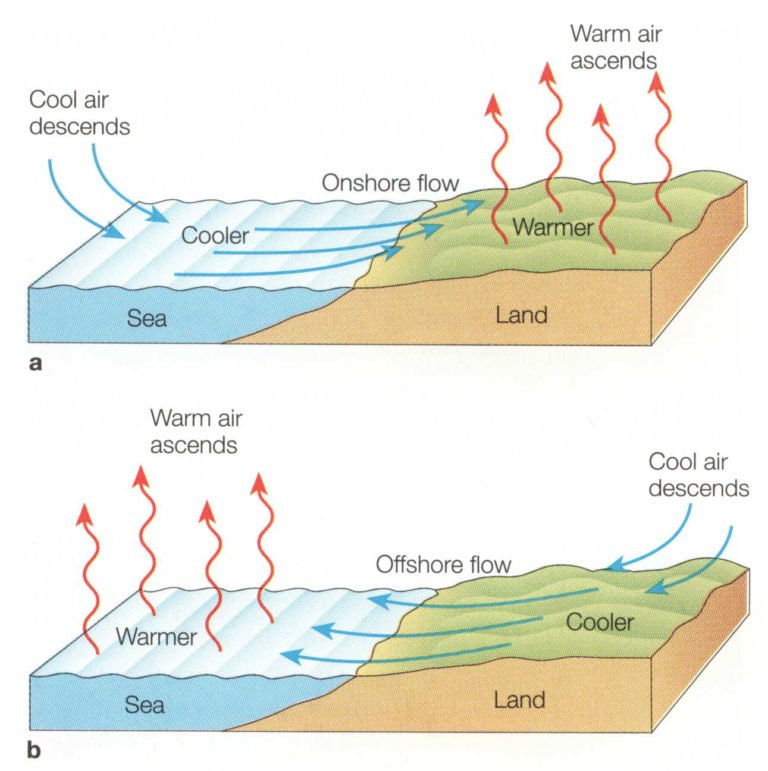
A similar effect happens at a global level as well. The Earth’s equator gets significantly more solar heating than the higher latitude bands to the north or south. The warm air at the surface around the equator rises and cooler air from higher latitudes flows in to reduce the pressure difference. This circular mixing of air is what creates our reliable trade winds that sailors have been using for hundreds of years and more recently what we’ve been utilizing to power offshore wind turbines.
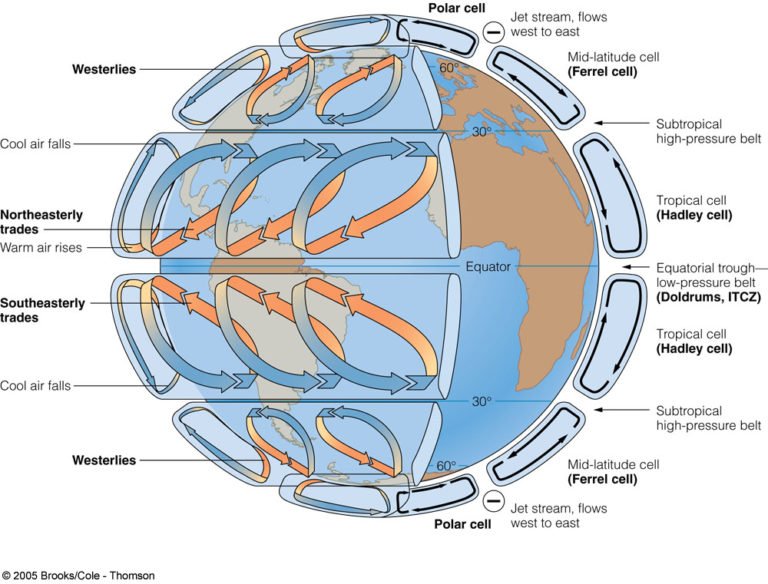
A flowing fluid like wind or water contains kinetic energy. This energy can be harvested and converted to useful mechanical or electrical energy using several different technologies. Turbines are by far the most common.
A turbine is a series of blades attached to a common hub which spin about an axis when acted upon by a fluid with kinetic energy. As wind flows across a turbine’s blades, the wind’s kinetic energy causes the turbine to rotate. If the shaft is connected to an electrical generator it will produce electricity when the turbine rotates.
The blades on a turbine have a unique shape and curvature that resembles a slender teardrop when viewed from the side. This unique shape is called an airfoil (or hydrofoil if its in the water). If you’ve ever been sailing or travelled in an airplane you have seen an airfoil at work in the sail or wings, respectively. These airfoil shaped blades rely on lift or drag to create the spin.
As air particles flow across an airfoil a low-pressure area develops on one side resulting in a force that acts on the foil in a direction that is perpendicular to the wind’s direction. This force is called lift and its what causes airplanes to fly. There is another force produced by wind flowing over a blade, but which acts in a direction parallel to the wind, which we call drag. Wind turbines can take advantage of either of these forces, but most blade designs try to maximize lift and minimize drag. For a more in-depth discussion on lift, see this article.

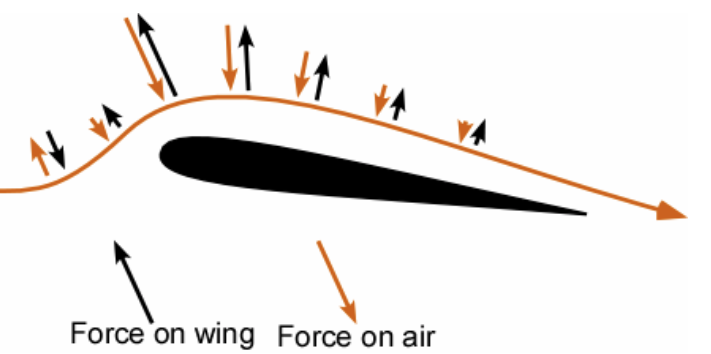
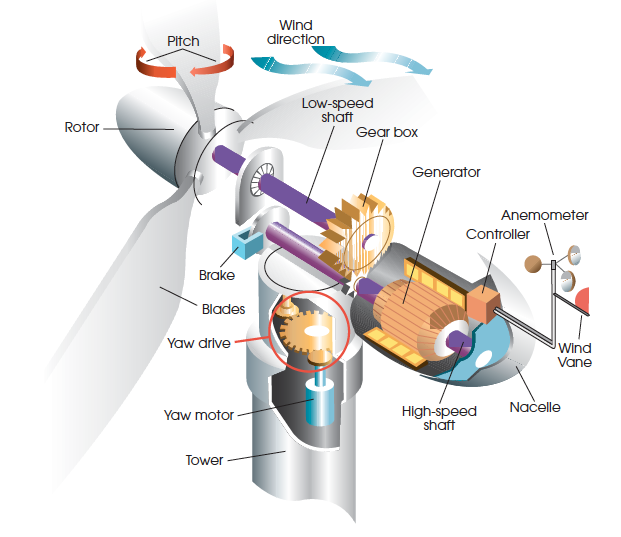
The power available to a wind turbine is given by the equation:
P = ½ A ρ V³
In the equation above, P is the power in watts, A is the area swept by the wind turbine in square meters, ρ is the air density in kilograms per cubic meter (around 1.2 kg/m³ for air), and V is the wind speed expressed in meters per second. This equation also applies to tidal turbines.
Notice that power is directly proportional to the cube of the wind velocity. So even a modest increase in the wind speed can have a tremendous effect on the available power. Likewise increasing the size of the turbine can also increase power – since the swept area is proportional to the square of the radius, or turbine blade length, increasing blade length leads to exponential gains in power.
This equation helps to partially explain two trends with offshore wind. First is the desire to move further offshore where there is cleaner and stronger wind. Second, offshore wind turbines have been trending towards ever bigger designs to maximize on power output.
One might assume that more wind is always a good thing. Wrong. Turbines are designed for an optimum range of wind speeds, but beyond that they will cut-out and stop producing power in order to protect the turbines gearing and generator. So just as too little wind can be a bad thing, so can too much.
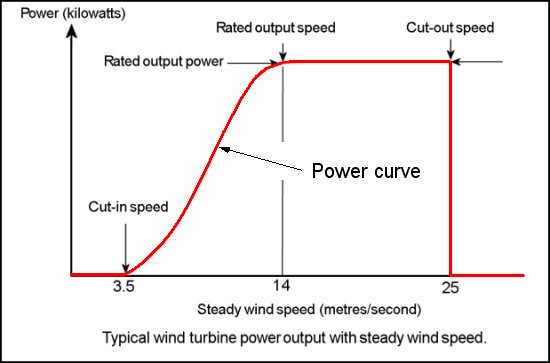
The equation above will provide the theoretical maximum power output from a wind turbine. In the real world we must factor how efficient the turbine system is at harvesting the wind. Even with the most efficient turbine, the maximum power that can be extracted from the wind is given 59.3% of the kinetic energy. This is what’s known as the Betz Limit. Modern offshore wind turbines obtain values that are around 80% of the Betz limit.
Offshore wind turbines are similar to their terrestrial counterparts, but are typically larger. Offshore wind turbines are larger because it pays to go bigger; the wind is more consistent, there are less obstructions, and if a company is going to go to the trouble to install a turbine in the ocean, they’ll want it to generate as much power as possible.
Offshore wind designs can be classified by their foundation type and the turbine design. When it comes to supporting the turbine there are three possibilities: fixed, floating, and airborne. For the turbine the majority of designs you’ll come across are either a variant of a horizontal axis turbine or a vertical axis turbine. Let’s look at each.
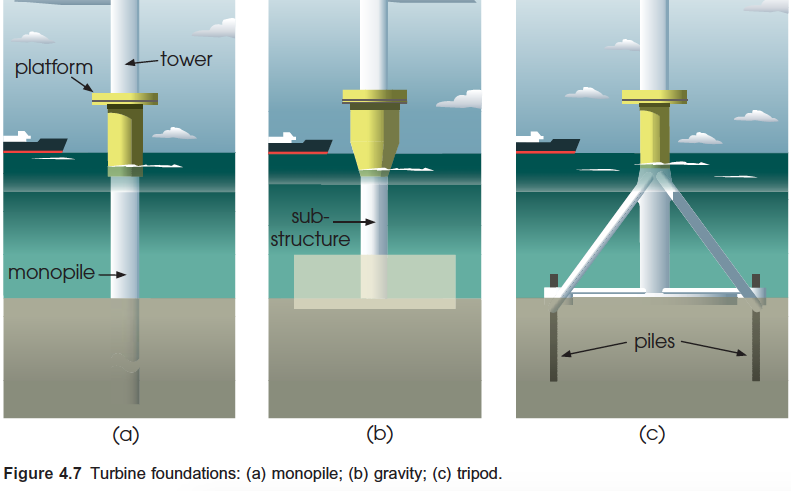
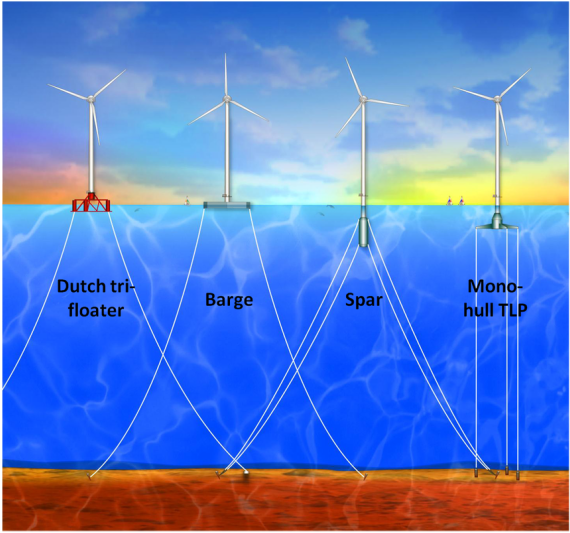
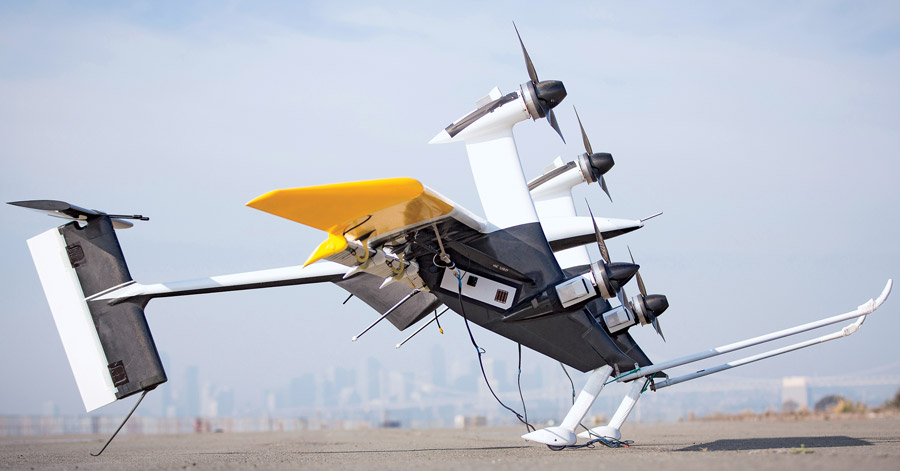
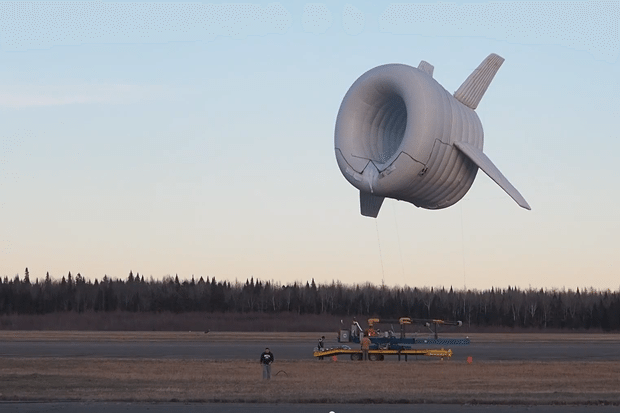
There are two general types of wind turbines commonly used, horizontal-axis wind turbines (HAWTs) and vertical-axis wind turbines (VAWTs). HAWTS and VAWTS are distinguished from one another by the orientation of the turbine shaft, but these turbines can also be differentiated based on whether the turbine uses drag or lift in the blades to turn the rotor, or whether the turbine rotor is facing upwind or downwind.
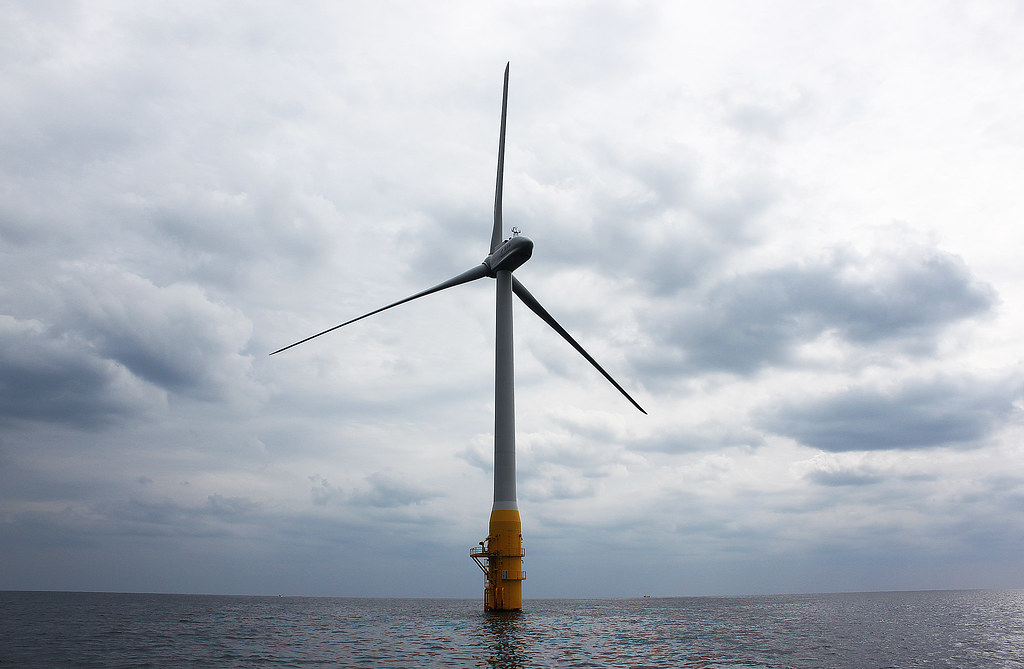
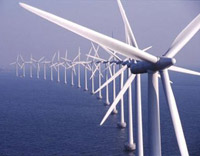
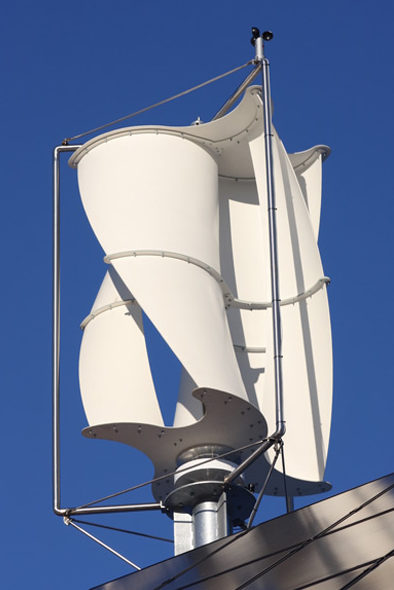
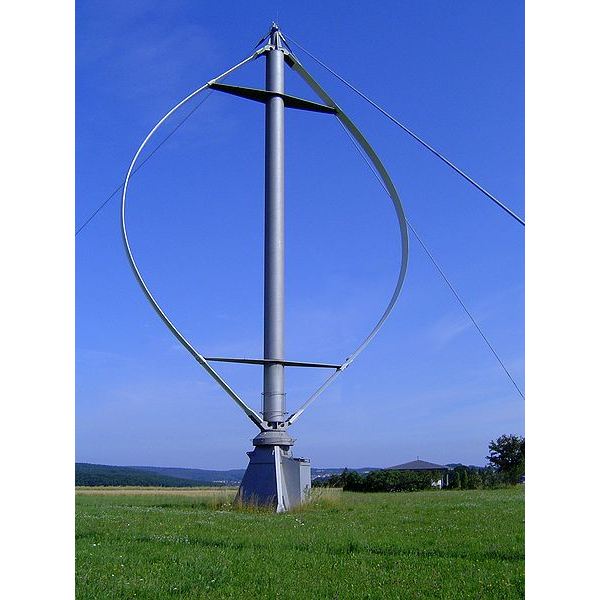
All energy harvesting technologies have evolved from fixed-bottom to floating systems via two distinct phases, some remarkably quickly.
The same winds that carried famous explorers like Magellan or Dora the Explorer away from shore are enjoying a renaissance with the offshore wind energy
American Wind Energy Association (AWEA)
International Energy Agency – Wind Technology Collaboration Program (IEA-Wind)
U.S. Department of the Interior, Bureau of Ocean Energy Management (BOEM)
U.S. Department of Energy, Wind Energy Technologies Office (WETO)
The Portal and Repository for Information on Marine Renewable Energy (PRIMRE)
Thanks for subscribing to The Liquid Grid! You’ll receive email updates when new articles are posted.